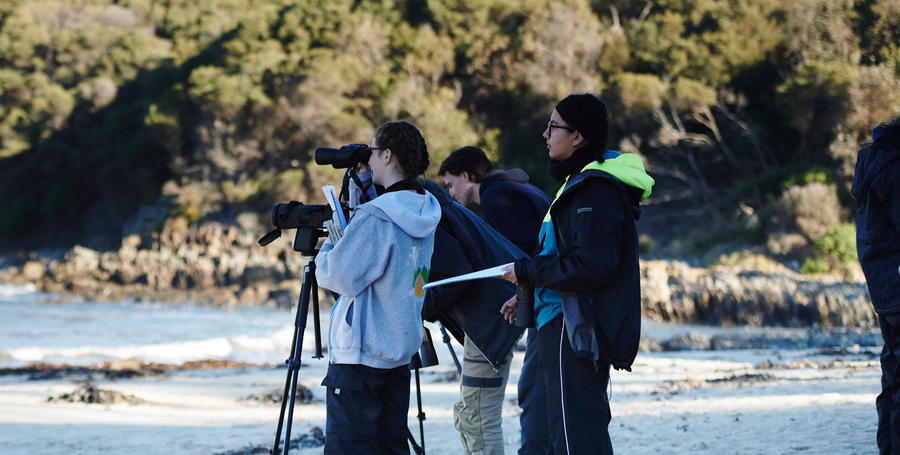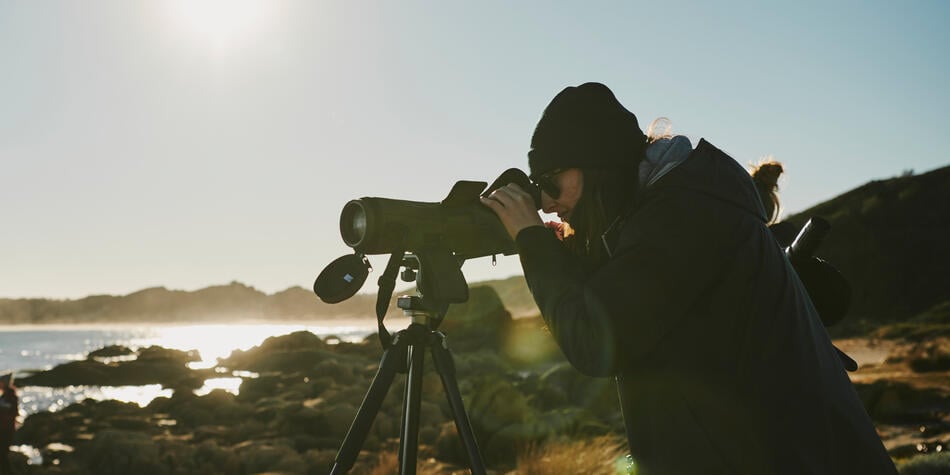While you can learn many things about wildlife, conservation and bushfires from a classroom, it’s no match for getting outdoors and having a hands-on experience.
From discovering how to identify animals and vegetation, to GPS navigation, handling small mammals and learning about the impact of fires, Deakin offers practical field trips and volunteer work from first year right through to an honours research year.
In Deakin’s Bachelor of Environmental Science (Wildlife and Conservation Biology), students engage in field training camps in Cape Conran, the Grampians National Park, the Otways and Anglesea.
That’s of course when they’re not – COVID-19 permitting – exploring the Amazon in Peru, studying wildlife in Costa Rica or finding out more about sustainability and conservation in Borneo.
The Cape Conran camp
In February 2021, students who completed their first year during the pandemic finally got the chance to head to Cape Conran, in remote East Gippsland.
Course director Associate Professor Raylene Cooke says Deakin has been visiting this location for 17 years, working alongside the Department of Environment, Land, Water and Planning’s (DEWLP) Southern Ark team on one of Australia’s largest fox-baiting programs.
The baiting program aims to reduce the number of foxes to help the survival of threatened mammals in the area, such as potoroos and bandicoots.
‘Students trap the potoroos and the bandicoots (temporarily) and get the opportunity to learn how to handle them,’ Assoc. Prof. Cooke says. ‘If it’s a new individual that’s never been caught before, they get the opportunity to microchip that animal so that they can track that animal into the future.’
Will, a student, says the camp was an ’amazing experience,’ allowing him to get hands-on experience and meet new friends after a year studying online.
‘I really enjoyed learning how to trap and handle small mammals. After three attempts I finally managed to handle one successfully!’
Recovering from bushfire
The 2021 camp was a unique experience compared to previous years, partly because many students hadn’t physically met their peers yet, Assoc. Prof. Cooke says.
‘We were also in a different location because our cabins had burnt down. Then, out in the field, we were working in areas that had been severely burnt 12 months previously.’
Associate Professor John White says the four-day camp gave students the chance to see the impacts of bushfire first-hand, and to learn more about climate change.
‘The reason that the fires occurred was that a massive area of southeast Australia had had a protracted drought prior to the fires, and so the animals were slowly disappearing anyway because of the drought,’ he says. ‘Then fire often follows drought.’

Students observing wildlife.
Discovering stories of survival
However Assoc. Prof. White says many animals survived the recent blaze by, for example, hiding in wombat burrows or deep in tree hollows.
Using camera traps – cameras mounted in the bush that capture images by detecting heat and movement – students were able to spot animals in the area.
‘The students could go out and put these cameras out, and then get the images back and find long-nosed bandicoots and other animals on cameras in areas that had been burnt,’ Assoc. Prof. White says.
Students were able to learn more about the science of bushfires, including what happens in the lead-up to fires and how an area recovers afterwards. Then there was the chance to chat with the DEWLP team about fire management.
Nick, a student, says visiting Cape Conran gave him the chance to experience the impact fires have on the landscape. ‘I was able to join the dots of things learnt in lectures to begin to see the bigger picture.’
Learn new field skills
While the first-year camp is an introduction to field techniques, camps in later years have more of a focus on working effectively in teams.
Students also continue to learn new field skills. For example at Anglesea, students carry out vegetation surveys and learn to correctly identify different types of vegetation.
‘By the third year programs, certainly in Cape Otway, students run and organise the wildlife field surveys there,’ Assoc. Prof. White says.
Students who go on to study honours in a fourth research year can also work in major bushfire research programs such as the long-term Grampians fire, climate and biodiversity program, which tracks how small mammals respond to fire and climate.
For Kim, her first field trip has given her the confidence to apply for volunteer roles. She also feels it’s set her up for success in her degree. ‘I can’t believe how much I learnt from the staff and my peers in just four days.’
Whether it’s a passion for conserving wildlife or a desire to make a real difference to our natural world, Deakin’s wildlife and conservation biology degree offers the hands-on experience and skills required to leap into an amazing career.
Want to learn more about bushfire management? Consider Deakin’s Bachelor of Environmental Science (Wildlife and Conservation Biology).

